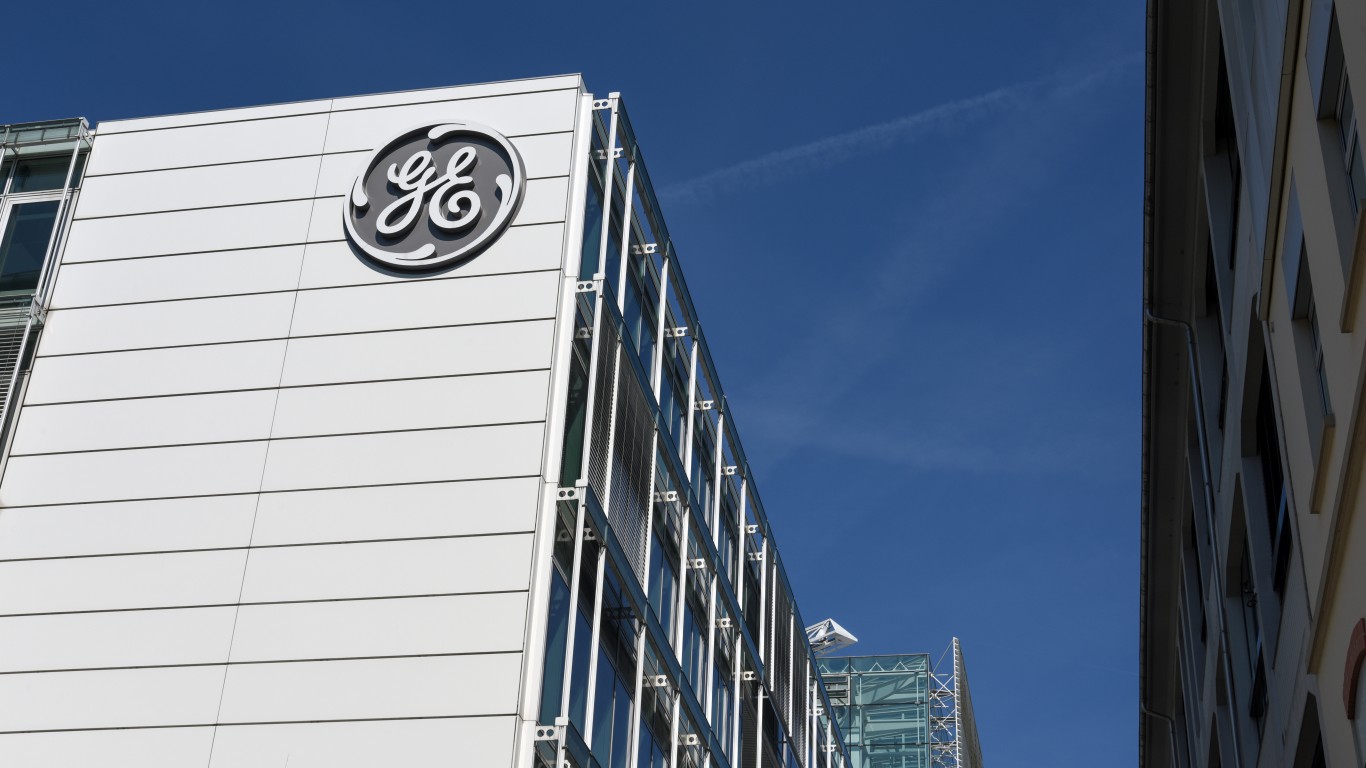Industrials
Earnings Driving General Electric Stock Toward New 52-Week High

Published:
Last Updated:

General Electric Co. (NYSE: GE) reported fourth-quarter and full-year 2019 results before markets opened Wednesday. The conglomerate reported adjusted quarterly earnings per share (EPS) of $0.21 on revenues of $26.24 billion. In the same period a year ago, GE reported adjusted EPS of $0.14 on revenues of $23.6 billion. Fourth-quarter results also compare to the consensus estimates for EPS of $0.18 on revenues of $25.77 billion.
For the full year, GE reported total revenues of $95.21 billion and EPS of $0.65, compared with 2018 revenues of $97.01 billion and EPS of $0.57. Analysts were looking for EPS of $0.62 and revenues of $92.79.
In the company’s four segments, quarterly revenues were either flat or up slightly. Power segment revenues were flat at $5.4 billion and health care revenues were also flat at $5.4 billion. Renewable energy revenues rose 2% to $8.94 billion, and aviation segment revenues rose 6% to $8.94 billion.
Free cash flow in the fourth quarter totaled $4.5 billion of a total $4.6 billion for the full year. These might be the two most important numbers in GE’s report.
The power segment posted a quarterly profit of $302 million, compared with a loss of $786 million in the year-ago quarter. The renewables posted a loss of $197 million, compared to a loss of $21 million a year ago. Aviation segment profits rose 19% to $2.06 billion, and health care profits were up 1% at $1.18 billion.
CEO Larry Culp crowed a bit:
The fourth quarter marked a strong close to the year for GE. We met or exceeded our full-year financial targets and are on a positive trajectory for 2020. … Our priorities looking forward are clear. We are solidifying our financial position, continuing to strengthen our businesses as improvement efforts build momentum, and driving long-term profitable growth. We remain committed to creating value as we continue our multi-year transformation.
For 2020, GE expects revenues from its four segments to grow organically in the low-single-digit range. Adjusted profit margin growth for these industrial segments is forecast in a range of zero to 75 basis points, and adjusted EPS for the year is forecast in a range of $0.50 to $0.60. Free cash flow from the industrial segments is forecast at $2 billion to $4 billion.
The outlook includes the disposition of BioPharma and reduced cash from Baker Hughes. In 2019, BioPharma generated about $1.3 billion in cash and $1.5 billion in profit, while Baker Hughes kicked in $350 million in dividend payments. Regarding its aviation segment outlook the company said:
This outlook is also dependent on the 737 MAX’s return to service, which GE is planning for in mid-2020, in line with Boeing. GE expects to offset these effects through performance improvements and reduced non-operational headwinds.
Analysts have estimated first-quarter EPS at $0.14 on revenues of $21.39 billion. For the full year, analysts expect EPS of $0.66 on revenues of $91.4 billion.
The best news from GE is that there were no more charges related to its long-term care insurance and that the company plans to remain “focused on de-risking GE Capital, including improving its leverage profile.” GE Capital posted $6 million in earnings for the fourth quarter, compared with a loss of $177 million in the same period last year, and the net loss for the year totaled $338 million, compared to a net loss of $2.16 billion in 2018. GE Capital dumped assets valued at about $12 billion in 2019, topping its target reduction of $10 billion.
The earnings report had no really bad news, although full-year revenues came up a bit short, as did the 2020 EPS guidance. The rise in cash flow, however, apparently forgives myriad lesser sins.
GE stock traded up about 3.8% in Wednesday’s premarket, at $12.17 in a 52-week range of $7.65 to $12.24. The consensus price target on the stock was $11.27 before the results were reported. GE pays a quarterly dividend of $0.01, and its annual dividend yield is 0.35%. Could investors be hoping for a bit more now that cash is flowing more freely?
If you’re one of the over 4 Million Americans set to retire this year, you may want to pay attention. Many people have worked their whole lives preparing to retire without ever knowing the answer to the most important question: am I ahead, or behind on my goals?
Don’t make the same mistake. It’s an easy question to answer. A quick conversation with a financial advisor can help you unpack your savings, spending, and goals for your money. With Zoe Financial’s free matching tool, you can connect with trusted financial advisors in minutes.
Why wait? Click here to get started today!
Thank you for reading! Have some feedback for us?
Contact the 24/7 Wall St. editorial team.